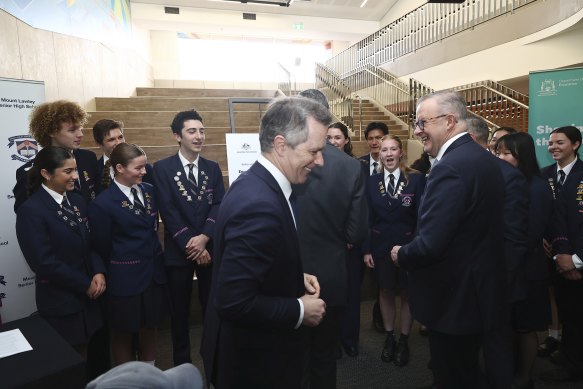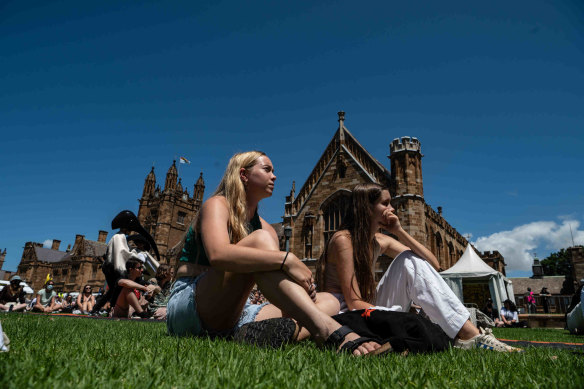By Paul Sakkal
Student debts could be slashed by tens of thousands of dollars under a radical Albanese government plan to make financially strained young Australians feel better off before next year’s election.
As Labor searches for a compelling cost-of-living pitch to lift it out of a political quagmire, the cabinet is examining moves to reduce the rising debt burden of graduates paying more for some degrees and struggling with the inflation-fuelled repayment spikes.

Prime Minister Anthony Albanese with Education Minister Jason Clare.Credit: Trevor Collens
Options under consideration include cutting the total student debt pile of $70 billion by up to 20 per cent, which would reduce individual loans by the same amount; changing or removing indexation for a period of time; tinkering with repayment rates or increasing the threshold at which a person must start paying off loans from the current income of $51,550; and pausing repayments for those on parental leave.
Several government and public service sources, unable to speak publicly about confidential policy work, confirmed Labor was looking at ideas to make student loans more equitable.
Ministers contacted by this masthead refused to discuss the proposals but did not deny the work was being done.
Decisions have not been finalised, sources said, but two backbenchers said an existing policy to wipe $3 billion in loans was appreciated by young people and there was a desire among backbenchers to do more on HELP debts – previously named HECS.

At Sydney University, like others around the country, young people are taking on higher debts as house prices continue to rise.Credit: Flavio Brancaleone
Prime Minister Anthony Albanese has faced weeks of media scrutiny, and hit out at media coverage in a private meeting with ministers on Wednesday, over his purchase of a $4.3 million house and rejected claims he sought flight upgrades from Qantas’ Alan Joyce, adding more impetus to the task of announcing headline-grabbing policies to give Labor a clear agenda.
Albanese, who is neck and neck in polling with Peter Dutton, said in an October caucus meeting that he would soon turn focus to a “big second-term agenda” that sources said would include HELP changes, universal childcare and new investments in TAFE.
Treasurer Jim Chalmers has said he is keen to avoid cost-of-living relief that fuels inflation, making the HECS changes attractive because they would not inject money into the economy.
People under 35 have been hit the hardest by multiple interest rate and rent rises and have seen their savings go backwards, according to Commonwealth Bank data from August.
Labor is in a political contest with the Greens to win the trust of a generation struggling to break into the property market and start families. The Greens and progressive crossbenchers have been calling for HELP changes.
A major expert review of universities earlier this year called for an overhaul of student loan calculations. It proposed repayments for each dollar above an income threshold – like income tax – rather than levying a whole income. The current system creates a perverse incentive for a person to stop their salary rising above an arbitrary threshold.
Australia’s university fee program is widely viewed as a successful scheme that has allowed many people to gain degrees. Their repayments act as a kind of payback to those taxpayers who didn’t go to university, but who fund degrees that lead to high-earning professions.
But the rising cost of degrees, including doubling the price of some arts degrees under the Morrison government and expensive post-graduate degrees, has led to many people incurring debts of over $100,000. Australians contribute more to tertiary study than most people in other OECD nations.
HECS architect Bruce Chapman, who helped design the scheme, said any changes would not have an immediate hip-pocket benefit because the repayments are levied as a proportion of a person’s income. The government could make the benefits immediate if it changed the thresholds or the rates of repayment.
“The changes would adjust the length of time it takes to pay off a loan. It would give a sense of moral justice and lower their debt burden,” he said.
Chapman said the most pressing reform was reversing the Morrison-era Job-ready Graduates scheme that doubled the cost of some humanities degrees and cut the price of more technical courses.
“I didn’t think things were too out of hand before Job-ready Graduates, but I do think now we have got a big problem.”
There are more than 15 repayment thresholds in the current scheme, ranging between 1 per cent and 10 per cent of taxable income, and payments kick in once graduates start earning about 50 per cent of the average wage, effectively acting as a levy on income tax for younger people whose debts make it harder to get a home loan.
More from Campus, our higher education hub
Which degrees will lead to the highest pay packets?
Six months ago these HSC students picked their degrees. Did they make the right choice?
Where to start when you don’t know what career you want
Feeling overwhelmed by uni applications? Here’s what year 12 students need to know
Search for uni courses using our interactive tool
Cut through the noise of federal politics with news, views and expert analysis. Subscribers can sign up to our weekly Inside Politics newsletter.